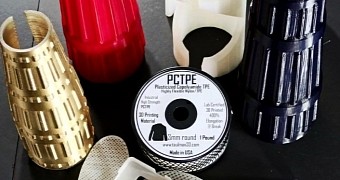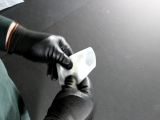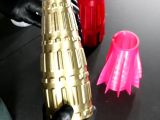Maybe it's a bit too grand to say that a new type of 3D printing filament could change the entire face of mankind, but no one can really deny that the latest invention from taulman3D could prompt a big transformation in terms of what things people are most likely to 3D print and how.
At the moment, PLA and ABS plastic are the main materials turned into filament for 3D printing, as many FDM printers can't use anything else.
Even those that can build things from other filaments usually end up being fed PLA or ABS regardless, since they're the cheapest and most common.
Flexible filaments have rapidly been gaining fame, however, and taulman3D decided that it was time for a very special kind of flexible filament to make its entrance.
The taulman3D PCTPE material
This material, short for Plasticized Copolyamid TPE, is made through a special “draw” process that stretches the material during the final manufacturing stage.
This tactic is normally utilized in the creation of large nylon ropes, the kind used for ships when docking, to keep the vessels in place.
Stretching the filament during the final manufacturing stage in that manner had two major effects. One is that it no longer has issues when printed through 1.75 mm extruders (normally, their flexibility works against them).
The second, bigger asset is the very high tensile strength, meaning that it won't fold or buckle like other flexible filaments.
By extension, it grants users the chance to 3D print objects with higher flexibility than usual, as well as broader options when setting 3D printing process parameters.
The benefits of PCPTE
Everything from paper-thin items to thick objects like shoe soles can be created, all with the optimum flexibility and without any hassle.
More importantly, 183 testers have shown that, in addition to being flexible and strong, objects 3D printed from PCTPE are non-delaminating (you can fold it along printed thread axes without it breaking apart), can be bent, rolled, pulled on, and even cut without becoming the least bit distorted.
You can probably already imagine how much better your next phone case, robotic parts, wearable gadgets, cosplay costumes, shoes, and fashion-related items will become. The video below goes into a bit more detail about the gains.
To acquire some of this awesome new filament, you only need to go to taulman3D.com and order some, either in the no-longer-troublesome 1.75mm form or 2.85mm spool. Two more materials should come out soon, but we don't know anything about them unfortunately.

 14 DAY TRIAL //
14 DAY TRIAL // 


